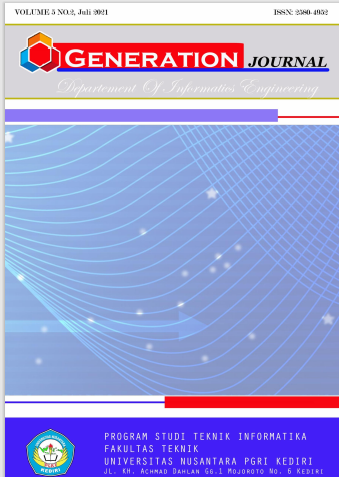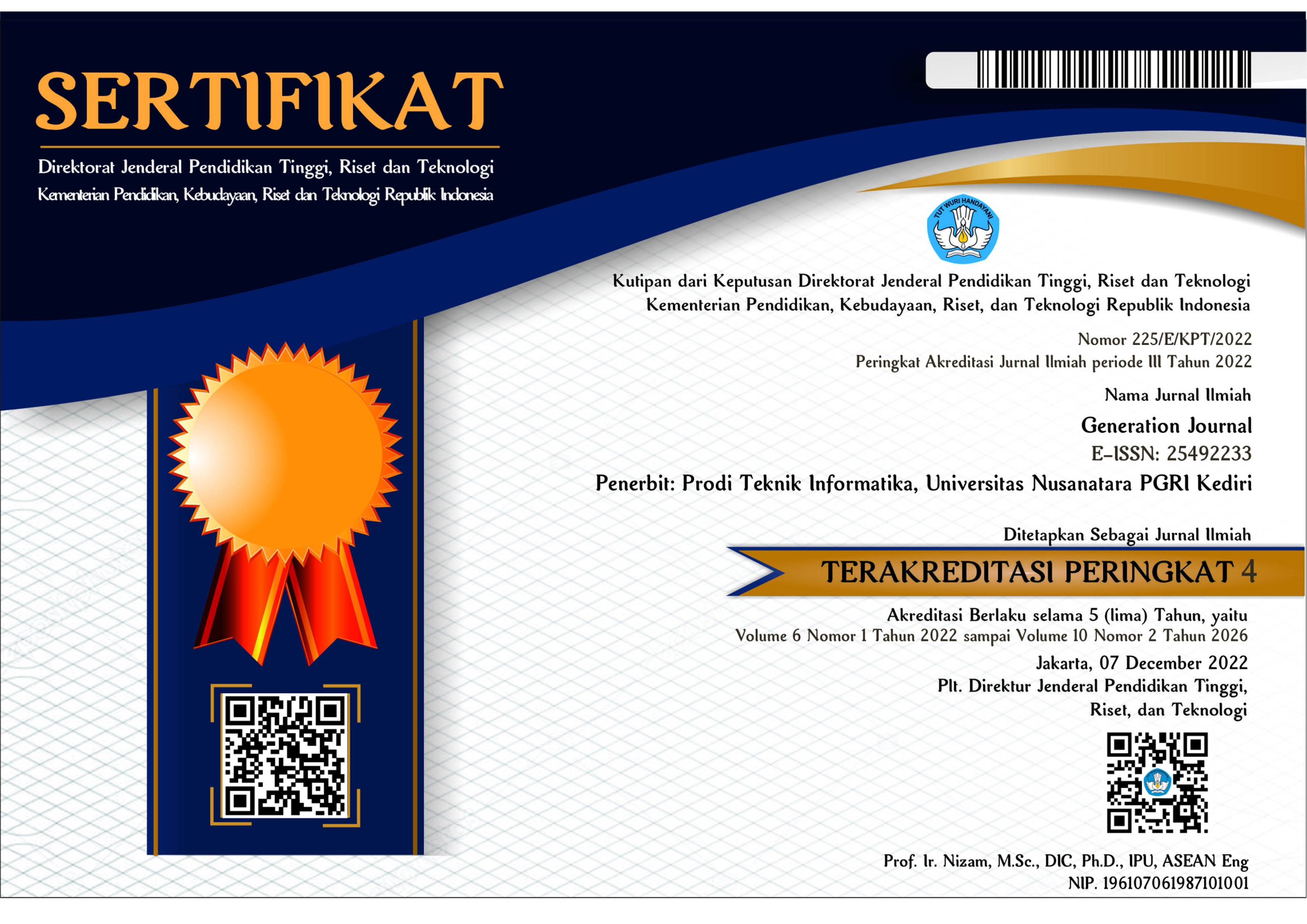Penerapan Artificial Intelligence untuk Kontrol Suhu dan Kelembapan pada Kandang Broiler berbasis Internet of Things
DOI:
https://doi.org/10.29407/gj.v5i2.15706Keywords:
Internet of Things, IoT, ESP32, Fuzzy Logic, PWM, Artificial Intelegent, Microcontroller, Covid-19Abstract
Abstract – Broiler chickens or broiler chickens are one of the popular sources of nutrition in Indonesia. The production of broilers reaches 3.15 billion heads, with the most production center on Java’s island. The Covid-19 disaster that hit Indonesia caused broilers’ production to decrease due to the government’s social restrictions. To maximize production and reduce production efficiency, artificial Intelligent application innovations are carried out for temperature, humidity, and gas control in broiler chicken coops. Artificial Intelligent methods of developing machines can think like humans to help control and make decisions. This artificial Intelligent model uses a fuzzy logic Pulse Width Modulator (PWM)model. The device used for control utilizes Internet of Things technology with a microcontroller as its primary device and sensor as an environmental data reader. The microcontroller used is ESP32 which has been embedded with Wifi to facilitate the transmission of data to the server. To read the sensors’ environmental conditions used by temperature sensors, humidity uses DHT11 and ammonia gas using MQ2. Environment data is sent to the server, which is useful for the user monitoring the cage environment’s condition remotely and, if needed, can be controlled by using the application interface. In this research, the process of system development using waterfall method, namely needs analysis, design, implementation and testing. The system’s application results were tested using two models, namely, trying the sensor reading value compared to the weight on the hygrometer and observation of the reaction of chickens in the cage. The test results obtained the difference in value between the sensor and hygrometer can be tolerated and the chicken reaction following the system’s cooling status.
References
[2] B. Tiesnamurti, Prospek peternakan di era normal baru pasca pandemi covid-19: pemanfaatan berkelanjutan sumberdaya genetik ternak sebagai penyedia pangan hewani, vol. 7. 2020.
[3] J. Cao et al., “Clinical features and short-term outcomes of 102 patients with corona virus disease 2019 in Wuhan, China,” Clin. Infect. Dis., 2020.
[4] A. Amam, Z. Fanani, B. Hartono, and B. A. Nugroho, “Usaha Ternak Ayam Pedaging Sistem Kemitraan Pola Dagang Umum : Pemetaan Sumber Daya dan Model Pengembangan,” Sains Peternak., vol. 17, no. 2, p. 5, 2019, doi: 10.20961/sainspet.v17i2.26892.
[5] S. Hazami, S. Hardienata, and M. I. Suriansyah, “Model Pengatur Suhu Dan Kelembaban Kandang Ayam Broiler Menggunakan Mikrokontroler ATMega328 Dan Sensor DHT11,” Univ. Pakuan, 2016.
[6] N. Juliasari and E. D. Hartanto, “Monitoring Suhu dan Kelembaban pada Mesin Pembentukan Embrio Telur Ayam Berbasis Mikrokontroler Arduino UNO,” J. TICom, vol. 4, no. 3, 2016.
[7] J. Husein and O. B. Kharisma, “Internet of Things (IOT) Development for The Chicken Coop Temperature and Humidity Monitoring System Based on Fuzzy,” Indones. J. Artif. Intell. Data Min., vol. 3, no. 1, p. 9, 2020, doi: 10.24014/ijaidm.v3i1.9294.
[8] R. Fatmaningsih, R. Riyanti, and K. Nova, “Performa ayam pedaging pada sistem brooding konvensional dan thermos,” J. Ilm. Peternak. Terpadu, vol. 4, no. 3, 2016.
[9] A. Ullah, O. B. Kharisma, and I. Santoso, “Fuzzy Logic Implementation to Control Temperature and Humidity in a Bread Proofing Machine,” Indones. J. Artif. Intell. Data Min., vol. 1, no. 2, pp. 66–74, 2018.
[10] X. Yang, F. Zhang, T. Jiang, and D. Yang, “Environmental monitoring of chicken house based on edge computing in internet of things,” Proc. 2019 IEEE 8th Jt. Int. Inf. Technol. Artif. Intell. Conf. ITAIC 2019, no. Itaic, pp. 617–620, 2019, doi: 10.1109/ITAIC.2019.8785634.
[11] V. Bloch, N. Barchilon, I. Halachmi, and S. Druyan, “Automatic broiler temperature measuring by thermal camera,” Biosyst. Eng., vol. 199, no. xxxx, pp. 127–134, 2020, doi: 10.1016/j.biosystemseng.2019.08.011.
[12] D. Wicaksono, E. Firmansyah, and H. A. Nugroho, “A microclimate closed house control design for broiler strain,” Proc. - 2017 7th Int. Annu. Eng. Semin. Ina. 2017, 2017, doi: 10.1109/INAES.2017.8068539.
[13] L. H. P. Abreu, T. Y. Junior, A. T. Campos, D. Lourençoni, and M. Bahuti, “Fuzzy model for predicting cloacal temperature of broiler chickens under thermal stress,” Eng. Agric., vol. 39, no. 1, pp. 8–25, 2019, doi: 10.1590/1809-4430-Eng.Agric.v39n1p18-25/2019.
[14] A. A. Masriwilaga, T. A. J. M. Al-hadi, A. Subagja, and S. Septiana, “Monitoring System for Broiler Chicken Farms Based on Internet of Things (IoT),” Telekontran J. Ilm. Telekomun. Kendali dan Elektron. Terap., vol. 7, no. 1, pp. 1–13, 2019, doi: 10.34010/telekontran.v7i1.1641.
[15] M. Ichwan, M. G. Husada, and G. N. F H, “Penerapan Fuzzy Logic Tsukamoto pada Pembangunan Kandang Ayam Pintar,” MIND J., vol. 1, no. 1, pp. 11–14, 2018, doi: 10.26760/mindjournal.v1i2.11-14.
[16] S. Ichiura, T. Mori, K. I. Horiguchi, and M. Katahira, “Exploring IoT based broiler chicken management technology,” TAE 2019 - Proceeding 7th Int. Conf. Trends Agric. Eng. 2019, no. September, pp. 205–211, 2019.
[17] I. Fahrurrozi and A. SN, “Buku Pintar Framework Yii,” J. Online STMIK, vol. 1, no. 2012, p. 120, 2015, [Online]. Available: mediakom-penerbit.com.
[18] “Understanding the pros and cons of the Waterfall Model of software development - TechRepublic.” [Online]. Available: https://www.techrepublic.com/article/understanding-the-pros-and-cons-of-the-waterfall-model-of-software-development/.
[19] A. K. Nalendra and M. Mujiono, “Perancangan PERANCANGAN IoT (INTERNET OF THINGS) PADA SISTEM IRIGASI TANAMAN CABAI,” Gener. J., vol. 4, no. 2, pp. 61–68, Aug. 2020, doi: 10.29407/gj.v4i2.14187.
[20] K. Petersen, C. Wohlin, and D. Baca, “The waterfall model in large-scale development,” in Lecture Notes in Business Information Processing, 2009, vol. 32 LNBIP, pp. 386–400, doi: 10.1007/978-3-642-02152-7_29.
Downloads
Published
Issue
Section
License
Authors who publish with this journal agree to the following terms:
- Copyright on any article is retained by the author(s).
- The author grants the journal, the right of first publication with the work simultaneously licensed under a Creative Commons Attribution License that allows others to share the work with an acknowledgment of the work’s authorship and initial publication in this journal.
- Authors are able to enter into separate, additional contractual arrangements for the non-exclusive distribution of the journal’s published version of the work (e.g., post it to an institutional repository or publish it in a book), with an acknowledgment of its initial publication in this journal.
- Authors are permitted and encouraged to post their work online (e.g., in institutional repositories or on their website) prior to and during the submission process, as it can lead to productive exchanges, as well as earlier and greater citation of published work.
- The article and any associated published material is distributed under the Creative Commons Attribution-ShareAlike 4.0 International License














